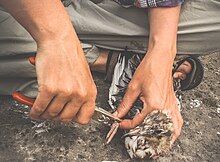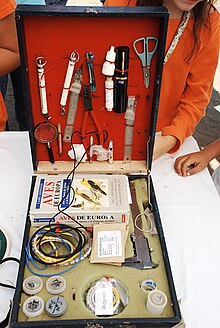
Back تحجيل الطيور Arabic Кальцаванне птушак Byelorussian Опръстеняване Bulgarian Anellatge d'ocells Catalan Kroužkování Czech Ringmærkning af fugle Danish Vogelberingung German Birdoringado Esperanto Anillamiento de aves Spanish Rõngastamine Estonian




Bird ringing (UK) or bird banding (US) is the attachment of a small, individually numbered metal or plastic tag to the leg or wing of a wild bird to enable individual identification. This helps in keeping track of the movements of the bird and its life history. It is common to take measurements and examine conditions of feather molt, subcutaneous fat, age indications and sex during capture for ringing. The subsequent recapture or recovery of the bird can provide information on migration, longevity, mortality, population, territoriality, feeding behavior, and other aspects that are studied by ornithologists. Other methods of marking birds may also be used to allow for field based identification that does not require capture.[1]
- ^ Cottam, C (1956). "Uses of marking animals in ecological studies:marking birds for scientific purposes". Ecology. 37 (4): 675–681. doi:10.2307/1933058. JSTOR 1933058.
© MMXXIII Rich X Search. We shall prevail. All rights reserved. Rich X Search